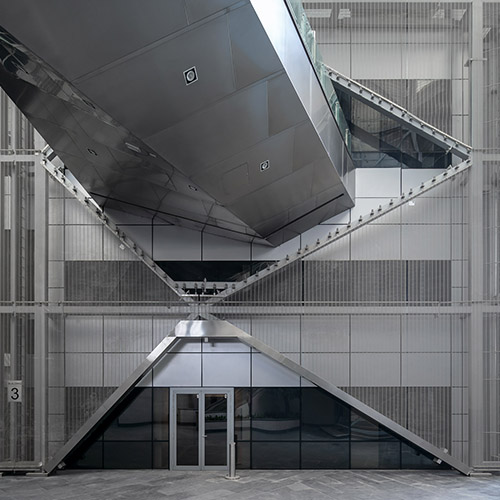5 Common Misconceptions about Architectural Mesh
In the world of architectural design, stainless steel architectural mesh is one of the most unique materials on the market. As a result, many architects aren’t too familiar with the material, naturally generating a handful of misconceptions.
From how it looks to how to attach it to a building, several factors can make architectural mesh intimidating. That said, once familiar with the material, integrating it into the architectural design process is a seamless experience.
With over 140 years of stainless steel wire mesh experience, W.S. Tyler is here to ensure that all your questions and concerns get answered.
With that, this article takes a deep dive into the 5 most common misconceptions about architectural wire mesh.
1. Architectural Mesh Is More Expensive Than Perforated Plate
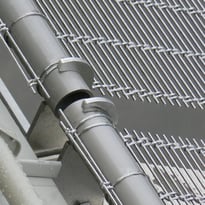 When it comes to the material, perforated plate is cheaper than architectural mesh. The average price range of architectural mesh is $15-$35 per square foot while perforated palate costs $5-$10 per square foot on average.
When it comes to the material, perforated plate is cheaper than architectural mesh. The average price range of architectural mesh is $15-$35 per square foot while perforated palate costs $5-$10 per square foot on average.
Now, the cost of a wire mesh system is less expensive than a perforated plate system. This is because costly framing systems with many layers must be put in place to use perforated panels.
Not only do these framing systems need more material than the mounting hardware of an architectural mesh system, but their installation process is also more labor-intensive. In other words, the cost of an entire perforated plate system is much greater than that of an architectural mesh system when looking at the project as a whole.
To get a better idea of how much architectural mesh costs, refer to our article: How Much Does Architectural Mesh Cost?
2. Architectural Mesh Can Be Placed onto Any Substructure
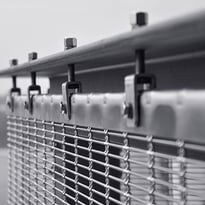 As architectural mesh is available in ready-to-install full-height panels, it can be tensioned over the full height of most structures. Having said that, adequate substructures that absorb significant loads, such as pre-tension, wind, and ice, must be installed before the mesh system is attached.
As architectural mesh is available in ready-to-install full-height panels, it can be tensioned over the full height of most structures. Having said that, adequate substructures that absorb significant loads, such as pre-tension, wind, and ice, must be installed before the mesh system is attached.
Failure to have adequate substructure can cause the tension of the system to cause damage to the building, putting visitors in harm's way.
Typically we see the substructure as hot-dipped galvanized L profiles at the top and bottom attachments with punched holes. These angles are usually 6 x 6 x ½” to accommodate the anticipated loads of our system. These loads could be between 1400-1800 lbs per linear ft.
3. There Are Standard Sizes and Shapes
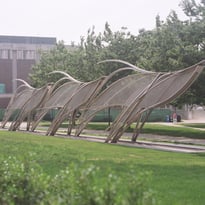 Many architects think that the application of woven wire mesh is limited to set shapes and sizes. Other than the patterns of the weave profile itself, there is no standardization of architectural mesh specifications.
Many architects think that the application of woven wire mesh is limited to set shapes and sizes. Other than the patterns of the weave profile itself, there is no standardization of architectural mesh specifications.
When you buy woven wire mesh for architectural applications, the dimensions, quantities, alloy, etc. are all customized to your specific needs. With that, architectural mesh is generally not stocked and is made-to-order.
As a result, lead times for architectural mesh are longer than other materials that are less custom. Approximately, lead times take 4 to 16 weeks depending on the project.
4. Architectural Mesh Looks the Same, Day or Night
 Architectural mesh is a unique design material, as its reflective qualities make it very dynamic. That said, a wire mesh facade, for example, will have different aesthetics depending on the surrounding environment.
Architectural mesh is a unique design material, as its reflective qualities make it very dynamic. That said, a wire mesh facade, for example, will have different aesthetics depending on the surrounding environment.
If there is direct sunlight shining on the mesh during the day, it's going to be opaque. At the same time, if there is minimal sunlight, some of the openings of the mesh are visible.
At night, the mesh is going to be very transparent as the garage light will provide backlighting. When the mesh is not being directly hit by sunlight, backlighting determines how it looks.
5. Paint Doesn't Adhere to Stainless Steel Mesh
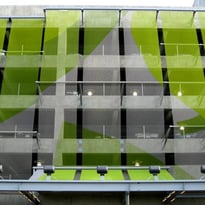 There is a general concern in the world of architectural design that paint will chip and is not a durable solution when introduced to stainless steel wire mesh. However, when painting architectural mesh, automotive-grade paint is used.
There is a general concern in the world of architectural design that paint will chip and is not a durable solution when introduced to stainless steel wire mesh. However, when painting architectural mesh, automotive-grade paint is used.
A primer, bottom coat, and topcoat is used during the painting process, leaving you with the amount of adhesion that is seen in automotive applications. This paint type is also known for having a high level of elasticity, meaning the paint will not chip, crack, or be compromised in any way when rolled into the shipping tubes.
Now, if someone was to attempt to deface your architectural mesh system with spray paint, it will not adhere. If this does happen, you can power wash it away with ease.
Get Creative with Architectural Mesh
Architectural mesh, while intimidating at first, provides a unique aesthetic that can create an unforgettable experience in and around any structure. It’s durable, corrosion-resistant qualities allow architectural mesh systems to last the lifetime of the structure.
Now, when compared to other materials, architectural mesh is one of the cheapest options out there when looking at the project as a whole and not just the material. But before you can start the installation process, you must ensure the building has adequate substructural support.
Once installed, you should understand that the way the mesh appears will change throughout the day. That said, any finish that is applied to the wire mesh, such as paints, will last the lifetime of the structure as well.
When you first start exploring the possibilities of architectural mesh, you find out that there are no standardized panel dimensions and are made to order. To make the most out of the qualities of stainless steel architectural mesh you need to gain a better understanding of the many applications that it is used for.
Having worked with stainless steel wire mesh for over 140 years, W.S. Tyler is here to guide you towards an architectural mesh solution that will optimize your design process.
For more information about how architectural mesh is used, refer to our articles: Pros and Cons of Architectural Mesh For Exterior Applications & Pros and Cons of Architectural Mesh For Interior Applications.
About Ronnie Brown
Ronnie is the Content Writer for W.S. Tyler and has four years of experience as a professional writer. He strives to expand his knowledge on all things particle analysis and woven wire mesh to leverage his exceptional writing and graphic design skills, creating a one-of-a-kind experience for customers.
